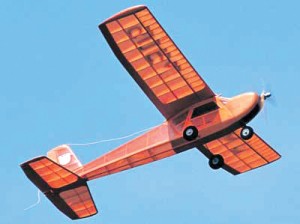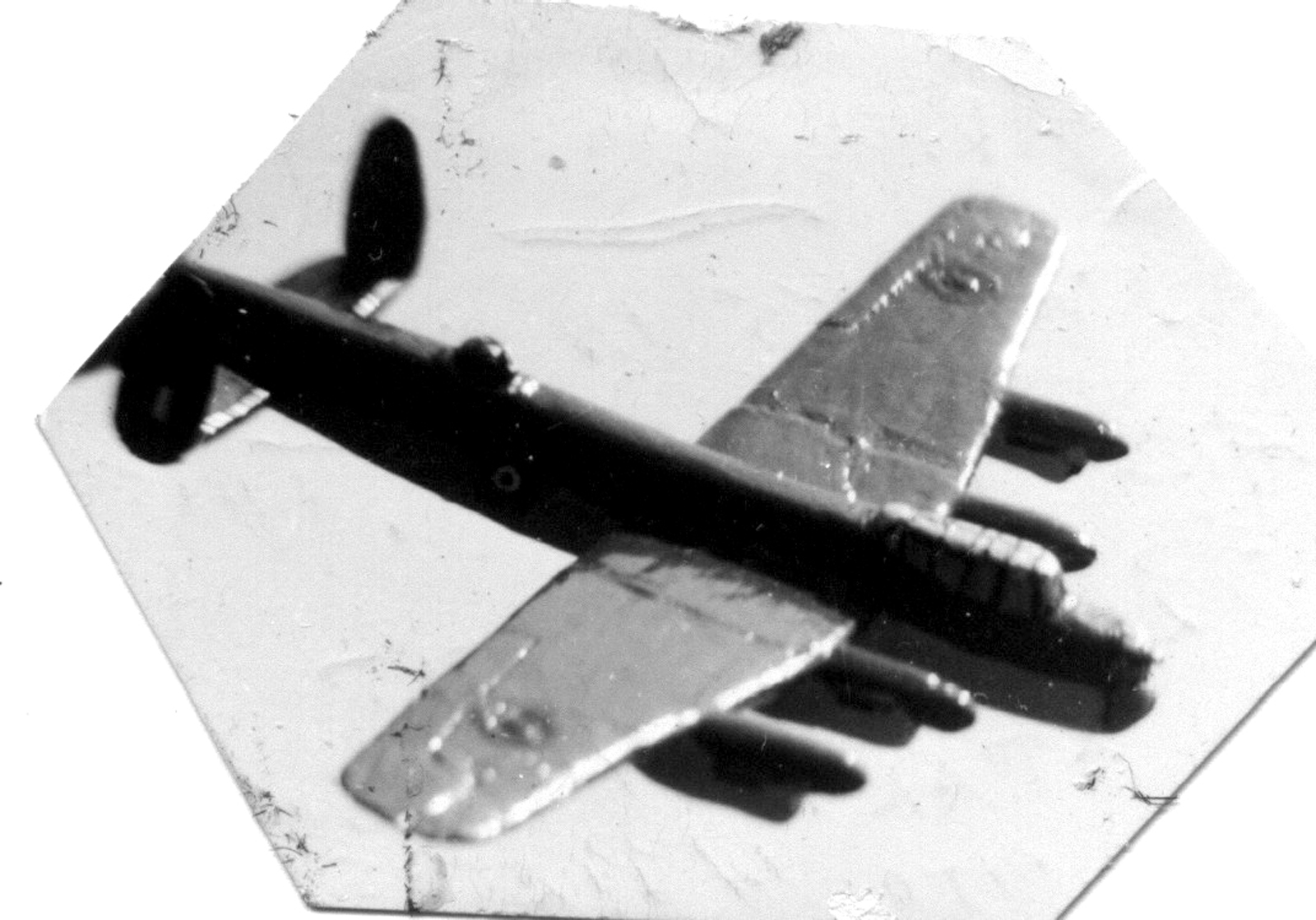
This scrapbook photo shows my solid model English Lancaster bomber. A dog ripped the model into 14 pieces, and the wings still showed the cracks after I rebuilt the plane.
By Fred “Crash” Blechman
They say that you can’t win a contest unless you enter. Well, in another world, in a time long ago, I entered a flying contest—and earned a trophy.
The “time” was in the late 1950s, back when things were simple. No cell phones. No personal computers. No email. If you’re over 70 years old, you’ll enjoy this trip down memory lane. If you’re younger, show this to your folks—especially if they were airplane nuts.
The “other world” is one that still exists today, populated by a rare breed of folks who possess many skills and interests. Most are part aeronautical engineer, part experimenter, part pilot, part inventor and part hobbyist, and they all have an incurable addiction to flying.
In order to properly transport you back to that time and place, let me flash back to how and when I got there myself. I suppose it began when I was 5 years old. Someone paid for me to take a ride in the right-hand front seat of a Beechcraft Staggerwing, on a flight over New York City. I was fascinated, looking down at all the tiny cars, the straight and twisting roads and rivers and the skyscrapers passing under our wings. And when the pilot simply moved the control wheel, the whole world turned, moving up and down. Amazing!
Starting then, and continuing on through my teenage years, I built model airplanes. First they were small models of World War One biplane fighters, like the Spad, Nieuport and Fokker. Not the snap-together plastic models of today—these models were painstakingly made from blocks and sheets of balsa wood, carefully cut, shaped, sanded and painted, just like the real planes.
Soon, I was building larger, solid models, like the English Lancaster bomber and the U.S. Army Air Corps B-17 Flying Fortress. When I wasn’t building models, I was hunting down and reading 10-cent pulp magazines, like “G-8 and his Battle Aces” or “Dare-Devil Aces,” with exciting flying stories about WWI fighter pilots. I’d devour any magazine about flying, learning all the terminology, like ailerons, rudder, elevator, thrust, drag, altimeter, horsepower, theory of flight and the rest.
As World War II began to unfold, I watched in awe, as movie theaters’ Movietone Newsreels showed combat photos of P-38s, P-47s and P-51s, fighting German aircraft and protecting American B-17 and B-24 bombers, while on their raids deep into Germany. I wanted to be a fighter pilot!
I progressed to building 10-cent flying models, made from balsa stringers and tissue paper. I twisted rubber bands through each fuselage, to turn a propeller in the nose. Before hand-launching the planes, I could adjust the wings, rudder and elevators to vary the flight path. What fun—especially when launched from the roof of my apartment building! I still have scrapbook photos of some of my models.
Although I was too young to get into flight training during WWII, I enrolled in the aeronautical engineering course at Cal-Aero Institute in Glendale, Calif., while waiting until November 1948 to get into Navy flight training. I finally reached my goal in August 1950, when I completed advanced training, made my qualifying aircraft carrier landings in an F4U Corsair and received my wings of gold. I was a Navy fighter pilot and served in VF-14 “Tophatters,” flying the F4U-5 Corsair on various cruises, until I left the Navy in November 1952.

My first radio-controlled model was a Rudderbug, ike the one in this photo. It flew like a champ, but eventually caught fire and burned to a crisp, hen a hot soldering iron came into contact with the doped wing.
Now what? I went back to Cal-Aero, under the G.I. Bill, graduated in January 1954 and immediately got married. While at Cal-Aero, I received a commercial pilot’s license. I would occasionally rent Piper Cubs or Aeroncas, to take other students up for joy rides around Grand Central Air Terminal, Cal-Aero’s base. When I married and entered the working world, the flying stopped. Then, along came our first child.
With only a modest income, I still managed to scrape together the $13,000 to buy a home in the San Fernando Valley of Los Angeles in 1955. Yes, that was the price for a three-bedroom home, with a large yard and a two-car garage. The garage became my workshop. I couldn’t afford to own or rent real airplanes—but I could now enter another world—the world of gas-powered flying models.
I built several gas-powered models, starting with U-control planes. I stood in the center of the plane’s circular path and controlled it with two wires. Except for overcoming dizziness as I turned with the plane, not much expertise was required to allow centrifugal force to keep the airplane control lines taut. I had a single hand control that provided the up or down elevator to cause the plane to climb or descend. When the engine quit, the trick was landing without crashing.
Sometimes, the toughest part was getting the glow-plug engine started and running properly. But, I had a lot of help in this world of engineers and tinkerers. We flew these planes at the U-control area in the model airplane section of San Fernando Valley’s Sepulveda Basin Recreation Area.
But others were flying radio-controlled airplanes, which I couldn’t resist. These were a lot more expensive to build and operate, and required considerably more building expertise. Operating on a small budget, I built my first plane from a kit. It was a Rudderbug, a five-foot wingspan, high-wing beauty, with a sturdy gas engine up front, driving a two-bladed prop. The radio equipment was a story in itself, since I built both the transmitter and receiver from kits that cost $5 each in 1958. At the time, factory-built transmitters and receivers were selling for the princely sum of $30 or more.
The Rudderbug name was chosen, apparently, because the primary control was the rudder. As I recall, we used a four-position, rubber-band-powered escapement for aircraft control. The radio had only one channel and operated on 27.255 MHz, the only Citizens’ Band frequency at that time. I would press a button on the radio transmitter, and the receiver would trigger the escapement to move control rods, connected to the rudder and elevator, to the next position. I recall the sequence as left rudder, right rudder, up elevator and neutral. I had to be fast on the pushbutton, to go from left rudder to neutral, for example. It had no throttle control. The engine operated at a constant speed, until it ran out of fuel.
The R/C world was full of helpful mentors, hooked on their hobby and more than willing to recruit others. With encouragement and help, I acquired more equipment and experience and built two more models from kits—a Mambo and an Esquire. All were painted bright red and yellow, so they could easily be seen, both in the air and while we tramped through the Basin corn fields, looking for planes that didn’t make it back to our small landing strip.
Because the corn was sometimes six feet tall, it was difficult to find a lost plane. Twice, I had to go to nearby Van Nuys Airport, rent a Piper Cub and fly over the Basin, to locate my plane from above. I would memorize the approximate location and then go back through the corn field, to retrieve it. I found my plane both times. These R/C equipped planes were usually worth well over 100 “1958 dollars,” not counting the building time and effort. That made the Cub rentals worthwhile.
Now, we come to the contest when I earned a trophy. Weekend R/C contests were common at the Basin, usually held on Sundays. I had never entered an R/C contest, but I felt I was now ready. I had my Esquire trimmed to fly in a broad circle, almost hands-off, and my radio equipment was operating perfectly. I had learned to control the plane properly, even when headed towards me (surprisingly confusing), as well as when flying away. I could control the turns and even make good landings when the engine quit.
So I entered the contest. It was a bright, sunny day. No clouds but a lot of wind. Most of the contestants decided it was too windy and turbulent to fly their models safely, but one brave soul’s plane took off—and after a short time, crashed. A second contestant’s plane took off from the runway. It flew about 100 feet, and then crashed. Undaunted, I was next. I started the engine, placed the plane on the starting line, let it go and off it went. My Esquire got about 10 feet off the runway, when a sudden downdraft slammed it into the ground, breaking the left wing. No other planes flew. The contest was canceled. But three trophies were to be awarded. Since I had the shortest flight, I received the third place trophy.
I repeat: “You can’t win a contest unless you enter.”
Fred Blechman’s two flying books, “Bent Wings – F4U Action & Accidents: True Tales of Trial & Terror!” and “Flying with the Fred Baron,” are available at [http://amazon.com] or [http://bn.com].











